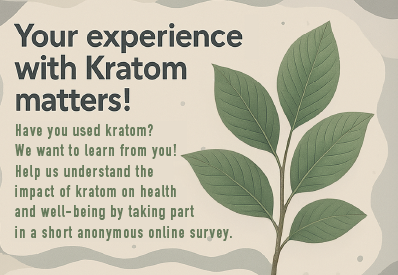Kratom, Evidence First | Empirical Community Research supported by Sirius Smartshop
Kratom, Evidence First
From roadside tea in Thailand to the counter of a Dutch smartshop, kratom has travelled a long way. In Southeast Asia, people have used the leaf for generations—for stamina on long shifts, to ease aches, to steady the mind. And in the Netherlands, smartshops have offered kratom for more than two decades. By now, kratom has become part of an established ecosystem, not a passing trend, and smartshops have seen the everyday realities up close for years: the patterns, the reasons, the questions customers bring to the counter. However, until now, Europe has lacked a rigorous, independent way to capture that picture at scale: Who uses kratom today? Why? What actually happens in daily life—and what does a sensible policy response look like?
At Sirius, we believe the best answers start with evidence—especially evidence that comes from the people who actually use kratom. That’s why we’re supporting a new study from Maastricht University titled “Kratom Use in Europe: Effects on Individual and Public Health.” The project taps into real-life experiences to inform public understanding and, ultimately, better policy. It runs with the support of the Dutch Smartshop Association (VLOS), and is designed so that vendors help with outreach without influencing the research process or conclusions. The result: wide reach to adult users with analysis kept fully independent.
Below, we put this study in context: kratom’s cultural roots, the problem of policy made in a data vacuum, why the Dutch smartshop ecosystem (via VLOS) can help build a bridge to decision-makers, and how Czechia’s new Psychomodulating Substances Act is a promising model for sensible, adult-only regulation. You’ll also find a simple way to take part by exploring Sirius’ kratom range, where participants can access the study invitation.
An old leaf with a modern life
Kratom (Mitragyna speciosa) grows in the tropics of Southeast Asia. Traditionally, small amounts were used like a pick-me-up; higher amounts could be more calming. Those two facets—the lighter, energizing side and the heavier, soothing side—help explain kratom’s modern appeal for everyday reasons people cite: getting through a long shift, unwinding after one, taking the edge off aches, or keeping a steady mood. When kratom reached Western markets, it arrived without that cultural context, and it quickly became a topic of debate—sometimes celebrated, sometimes vilified, often misunderstood.
Importantly, there’s now a sizable community in Europe and beyond who say kratom helps them in meaningful ways. Large user surveys (in multiple countries) consistently report self-described benefits such as mood support, pain relief, help with focus and energy, and—in a subset—assistance when reducing or replacing other substances. Even though these self-reports aren’t medical advice, their consistency across thousands of users is a signal worth studying—and learning from.
When policy runs ahead of data
If there’s one pattern we’ve seen repeatedly in drug policy, it’s this: policy often leads with fear and only later looks for data. New or lesser-known substances appear; a few incidents make headlines; bans are proposed. But in the absence of robust, local evidence, it’s hard to know whether a ban will reduce harm—or push people to unregulated channels, counterfeit products, and riskier behavior.
With kratom, the European landscape has been patchy. Some countries restrict or prohibit it; others allow sales. This fragmentation leaves consumers confused and policymakers flying blind. And it’s precisely where community-based research can make a difference. By asking the basic questions—Who’s using kratom? How? What do they experience?—a study like the Maastricht project replaces guesswork with European data on European users.
A study designed for real-world voices
The kratom study now underway is deliberately simple from a participant’s point of view: an anonymous online questionnaire that takes about 10 minutes for adults with kratom experience. It’s focused on patterns of use, well-being and lived experience, and basic views on policy scenarios. No personal identity is collected; participation is entirely voluntary.
What makes this study different is how it reaches people. Instead of casting a generic call on social media, the invitation is shared at the point of sale via participating smartshops through a short note in a confirmation email after you’ve bought kratom online, or a small QR flyer tucked into your parcel. That way, the survey is shown to adults who actually use kratom, not random internet traffic. At the same time, the academic team keeps full independence in data handling and analysis. Vendors and VLOS help with reach, not with results.
VLOS: the bridge in the middle
The Dutch Smartshop Association (VLOS) is a practical bridge between three groups who rarely sit at the same table: people who use kratom, the retailers who see real-world patterns every day, and the policymakers who write the rules. In the context of this study, VLOS helps bring those perspectives together by coordinating outreach through smartshops and creating a direct channel between researchers and the community. This not only ensures that real-world experiences are included in the data, but also gives policymakers a clear pathway to evidence and stakeholder feedback, before designing laws that affect everyone.
We’re fans of that approach. It treats adult consumers as partners in public health, not as problems to be solved. And it gives authorities something they rarely have at the outset: current data about how, why, and with what effects a substance is being used in their own jurisdictions.
A model worth watching: Czechia’s Psychomodulating Substances Act
Zooming out, one European country is already testing a modern, pragmatic framework. Czechia’s Psychomodulating Substances Act—approved in 2024 and rolling out from early 2025—creates a distinct category for lower-risk psychoactive substances (including kratom and low-THC cannabis) and regulates them for adult-only sale in licensed outlets. The rules require health warnings and explicitly ban sales via vending machines or in candy-like formats that might appeal to minors. The goal is to keep access legal and controlled, rather than pushing demand underground.
Czechia’s approach shows that regulation doesn’t have to mean prohibition. By recognizing that kratom is already widely used and that many adults report benefits, while still addressing potential risks, the state has chosen to shape the market rather than ignore it. The model acknowledges adult autonomy, protects minors, and focuses enforcement where it matters—on standards, licensing, and transparency. It’s a direction many health and policy experts have praised as more proportionate and more likely to reduce harm than blanket bans.
Why this matters in the Netherlands (and beyond)
The Netherlands has a long tradition of pragmatic thinking and harm reduction. The smartshop ecosystem, with a history of more than 30 years, is one expression of that, and VLOS’ role in this study is another example. By helping ensure the survey reaches adult users at scale—while preserving academic independence—our community can surface actual patterns and needs. That in turn gives policymakers the raw material for better decisions: if many users report manageable, everyday benefits; if some report difficulties that need attention; if certain product formats cause more problems than others—that’s the kind of nuance you can only see when you ask.
And nuance travels. European regulators are watching one another. If the Czech model demonstrates that a regulated, adult-only channel can work—reducing youth exposure, improving labeling and quality, and keeping consumers out of grey markets—other countries can adapt those lessons. Evidence is contagious (in the best possible way).
From stories to signals
Kratom conversations can quickly become polarized. You’ll hear one camp say it’s a miracle herb; another insists it’s a menace. Reality, as usual, lives in the detail: who is using, how, why, and with what effects over time. The most compelling thing about the current wave of kratom research isn’t any single headline—it’s the consistency of the stories people tell: better mornings, fewer rough evenings, an alternative to something harsher, a small tool that helps keep life moving. Those stories don’t make kratom risk-free; nothing is. But they’re strong enough, and numerous enough, to deserve statistical weight in the policy conversation.
That’s what this study offers: a way to transform everyday experiences into signals policymakers can actually use—signals about benefits and trade-offs, signals about formats and dosages, signals about what responsible, adult-only access might look like in practice.
What participation looks like (quick & anonymous)
If you decide to share your experience, it’s straightforward:
- The study is open to adults with kratom experience
- Participation is via an anonymous online questionnaire (about 10 minutes).
- The invitation is included with kratom purchases from Sirius and other participating shops—either in your confirmation email or as a small QR flyer in your parcel.
- There’s no payment; the value is collective: you help build a better evidence base for everyone.
No survey link is posted here; access comes through participating products only. That keeps outreach focused on real users and helps maintain data quality.
Sirius’ role, and how you can be part of the evidence
Sirius has been part of the European smartshop community for decades, serving adults who choose to explore botanicals like kratom. Our role isn’t to declare kratom “good” or “bad.” It’s to offer responsible access, share clear information, and support the research that moves conversations beyond guesswork. We’re optimistic because so many people tell us that kratom, used thoughtfully, makes a tangible difference in their everyday well-being. We’re careful because people are different, bodies are different, and context matters. Both can be true.
What excites us most is the cooperative structure behind this study: smartshops (via VLOS) help reach the community, researchers keep full independence, and policymakers gain data they can trust. That’s how evidence-based policy grows—through partnership, not polarization.
If you’re curious to explore kratom yourself, Sirius offers a range of well-known green, white, and red varieties. And right now, acquiring kratom from Sirius (or another participating vendor) is also how you receive the study invitation. If you decide to buy one of our products and take part in this landmark project, thank you—your voice helps make the kratom conversation smarter, fairer, and more grounded in reality.
References
Grundmann, O., Veltri, C., Morcos, D., Knightes, D., Smith, K., Singh, D., Corazza, O., Cinosi, E., Martinotti, G., Walsh, Z., & Swogger, M. (2022). Exploring the self-reported motivations of kratom (Mitragyna speciosa Korth.) use: a cross-sectional investigation. The American Journal of Drug and Alcohol Abuse, 48, 433 - 444. https://doi.org/10.1080/00952990.2022.2041026.
Müller, E., Hillemacher, T., & Müller, C. (2021). Kratom use for depression/anxiety self-management: challenges during the COVID-19 pandemic – A case report. Heliyon, 7. https://doi.org/10.1016/j.heliyon.2021.e07039.
Did you enjoy reading this article and do you like to write yourself? We are always looking for people who share our passion for natural products, who can also translate this into great texts. And we have an interesting reward for this. View all information for writers.
 Blog Mescaline Cacti
What is the best way to consume the mescaline cactus San Pedro?
The other day someone told me about his trip with San Pedro, together with a friend. It was a life-changing experience in which he came very close to [..]
17-03-2022
8 minutes
Blog Mescaline Cacti
What is the best way to consume the mescaline cactus San Pedro?
The other day someone told me about his trip with San Pedro, together with a friend. It was a life-changing experience in which he came very close to [..]
17-03-2022
8 minutes
 Blog Organic Cannabis Growing
What are the best Sativa and Indica cannabis strains to grow this spring 2022?
Time to write a blog about the very best cannabis strains to grow this spring of 2022. Buy cannabis seeds and grow the best quality weed for the entir [..]
25-08-2020
8 minutes
Blog Organic Cannabis Growing
What are the best Sativa and Indica cannabis strains to grow this spring 2022?
Time to write a blog about the very best cannabis strains to grow this spring of 2022. Buy cannabis seeds and grow the best quality weed for the entir [..]
25-08-2020
8 minutes
 Blog Psychoactive Plants
Trip Report: Lively dreaming with Calea zacatechichi
Dreamherb, or Calea zacatechichi, is a plant used by Aztec shamans from Mexico to help them navigate the dream world. This plant has only recently cau [..]
Blog Psychoactive Plants
Trip Report: Lively dreaming with Calea zacatechichi
Dreamherb, or Calea zacatechichi, is a plant used by Aztec shamans from Mexico to help them navigate the dream world. This plant has only recently cau [..]












 Nederlands
Nederlands Italiano
Italiano Deutsch
Deutsch Français
Français Português
Português Español
Español Polski
Polski